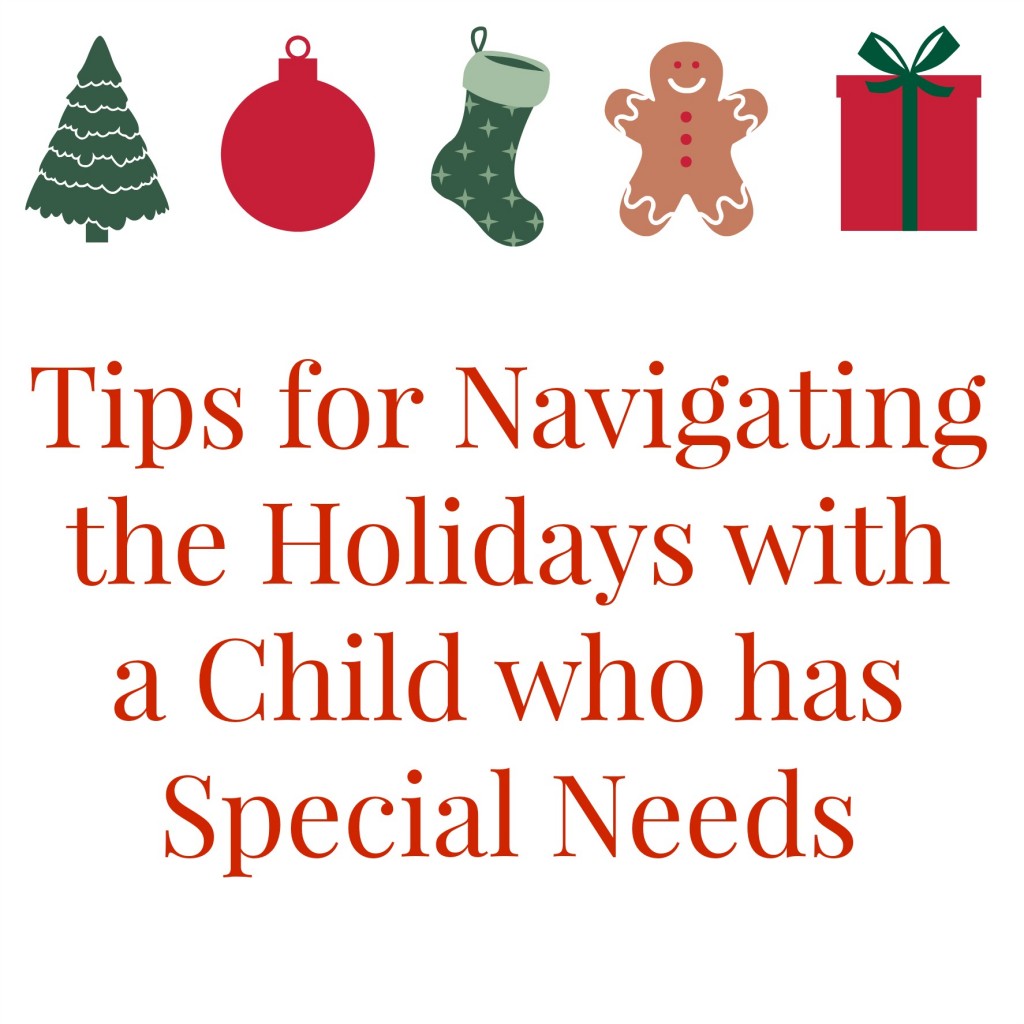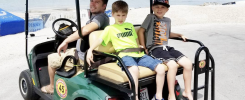The holidays are coming! Christmastime is my very favorite time of the year. I love celebrating the birth of Jesus, giving gifts, baking cookies, holiday lights, the joyfulness, and the hustle and bustle of the season. My kids on the other hand? Not so much. I mean yes, they LOVE the whole gift thing and all the fun activities our family does, but it is also so overwhelming for them and causes many meltdowns. Additional planning goes into making sure everyone enjoys the season.
I’m excited to share some great hints to get through this holiday season for those parents of children who have Autism, Sensory Processing Disorder, and self-regulation difficulties. Cara Koscinski, MOT, OTR/L, Author of The Pocket Occupational Therapist, helps us navigate the holidays with some tried and true strategies that she personally uses and recommends to her clients.
Shopping
We are all familiar with the chaos and stress that ensues at the malls and stores during the holidays. Scents, bright colors, and music can be extremely overwhelming to anyone, and this can be significantly magnified when a child has sensory processing difficulties. Even standing in long lines can prove to be extremely uncomfortable for kids.
1) Allow children who are overwhelmed by sights and sounds of shopping to stay home. Ensure that the child is comfortable and familiar with the sitter. Allow kids to have a pajama and movie night while you’re shopping.
2) Children enjoy giving gifts, but if they cannot go to the store, purchase a few gift items for family members and set up a store at home. We call ours, “Santa’s Workshop.” Our boys choose a gift for family and they go to the “wrapping station.” Help the kids to wrap and decorate the gifts with markers or stickers.
3) If a child must attend the shopping trip, schedule downtime or breaks for children to de-sensitize. This can be located in the car with some crunchy snacks, a weighted blanket, and some calming music.
4) Keep organized and ask children to help you create shopping lists. Permit the child to mark off completed tasks and errands so that he has some control of the situation.
5) Encourage children to make a list of preferred toys well in advance. Give family lists of toys to choose from. I even purchase the toys my children will enjoy and provide them to my local family members ahead of time. We sometimes have a “trunk sale” and everyone chooses which gift they will buy and wrap for my boys.
Family Photographs
1) Go at a time of day when children are well-rested and not hungry. Do not rush and arrive early. Even though you may not realize it, children pick up on your energy and mood. Try to remain calm and relaxed about the photo shoot. Some of the best pictures are candid and taken at un-expected times.
2) Write a letter or speak to the photographer ahead of time. Most studios will schedule extra time for children who have special needs. Request a photographer who is patient. If possible, schedule a photographer to visit your family outside of the studio. We have found that this may be a more affordable option than a studio because of low-overhead costs.
3) Use social stories and real-life pictures about what the child will encounter during the photography process. Practice often. Explain that the bright lights/flashes are OK and will not hurt children. Photography props are often wonderful distractions for kids.
4) Permit a child to have a transition or “safe” item. In every one of my family’s holiday pictures there’s an item that doesn’t quite belong, such as a train car or Minecraft figurine. Remember that the memories of family being together should be more important than the “perfect” picture.
5) Be flexible. Consider that “fancy” clothes are often scratchy, have tags, and may contain textures that aren’t familiar to children. Permit the child to wear comfortable versions of colors that you’d like the family portrait to have. For example, last year we used blue and while colors. My younger son will only wear soft sweat pants so we permitted him to wear blue sweats. We all matched, and no one was the wiser!
Visits with Santa and Holiday Traditions
1) Make a plan of all the things your family wants to accomplish during the holidays. Allow your child to participate and explain that while there are things everyone must do, other things can be flexible. For example, choose a visit to see the local holiday light show or the light-up night at the shopping plaza. Post the schedule in a central location and review it daily.
2) As my children grew, I had high expectations that the traditions we had in our family would continue. This was not the case. Instead of feeling let-down, we decided to begin fresh. Every year, I permit my boys to choose the types of lights on our tree, colored or white. They love being given the choice. We permit them to help decorate the tree and do not move the items which are clustered together or imperfectly perfect!
3) No holiday is complete without the visit with Santa Claus….not true for all kids. My older son never enjoyed or felt comfortable looking at someone in a costume. It seemed as though he always knew that Santa was a “helper” and not the real deal. To make the memory of Santa special, we take children who are younger, such as cousins or neighbors, to see Santa and my son enjoys seeing their excitement!
4) If children do agree to see Santa, create a social story with pictures of Santa, including his beard, velvet/soft red suit, and the setting in which Santa will be located. Go to the location prior to the visit and watch other children. Practice, practice, practice!
Holiday Parties
1) Give kids a job to do so that they will have a sense of belonging and success. Even something such as helping to create place markers for seating or setting the table can give kids a feeling of accomplishment.
2) Remember that heavy work is generally calming. Include activities such as moving chairs, picking up and placing dirty clothes into a basket and carrying it to the laundry room, or vacuuming are great ways to encourage children to help to prepare for the party.
3) Encourage comfortable clothing and avoid new and scratchy clothing. Family gatherings should be focused on providing fun memories and not on appearance.
4) Practice greetings ahead of time. My son does not enjoy hugs, so we practice reaching out his hand for a handshake or high five. Let family and guests know ahead of time that your child shows affection, but in a different way.
5) Consider food allergies and sensitivities. Bring extra “safe” foods that match what others are eating to be sure children feel included. For example, if cousins are eating macaroni and cheese, we prepare my son’s gluten free version and bring it along. Out of respect for the host, talk with her ahead of time and thank her for hospitality.
6) Plan an “out” or an escape plan. Even a short visit that is successful can create memories that last a lifetime! Remind yourself that the holidays are about fun and not stress. Don’t be hard on yourself or your child.
Family Gatherings
1) Utilize relaxation techniques such as deep breathing and meditation. Social stories can help with anxiety. Whenever possible, use actual pictures and rehearse as much as you are able.
2) Create a “safe-zone” to which the child can go whenever they feel overwhelmed. Set a password or sign that your child can use to excuse himself. Place a bean bag, calming music, a heavy blanket, and favorite hand fidget toy in the area. Practice ahead of time.
3) Use calming scents such as vanilla during the party. Essential oils can be calming in scents such as lavender. Encourage your child to choose scents prior to the event and keep them accessible.
4) Create a letter to family members prior to family gatherings to explain your child’s wonderful progress toward goals and suggestions for conversation topics. For example,
“Joshua’s had a wonderful year in therapy. He’s learned how to tie his shoes, take one turn during conversations, and how to write in cursive. Joshua likes Angry Birds. Here’s a link to the Angry Birds’ website if you’d like more information. Please know that even though he’s not looking directly into your eyes, he IS listening to you and loves you!”
5) At mealtime, make sure to serve a preferred food so that children who have feeding difficulties can successfully participate. Encourage positivity during family mealtime.
6) Rehearse family’s names and match them to their picture. We practiced family recognition beginning in November. When the child is familiar with the person’s name, add the family member’s interest such as favorite color or food, occupation, or hobby.
What tips do you have? Share them in the comments below! :)


















Tips For Navigating The Holidays With A Child Who Has Special Needs…
The holidays are coming! Christmastime is my very favorite time of the year. I love celebrating the birth…